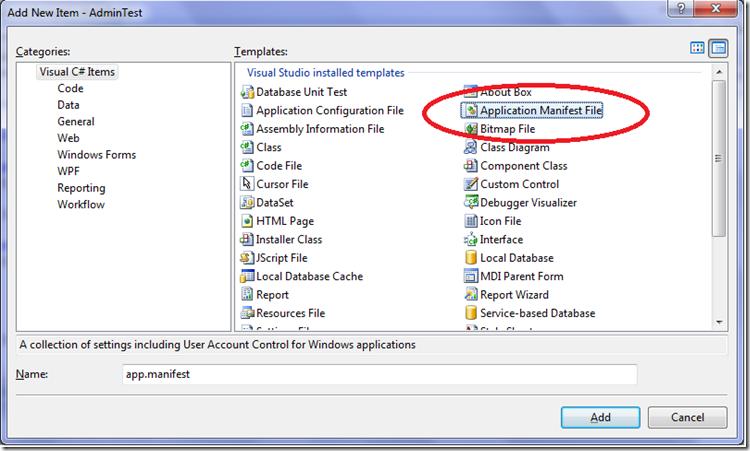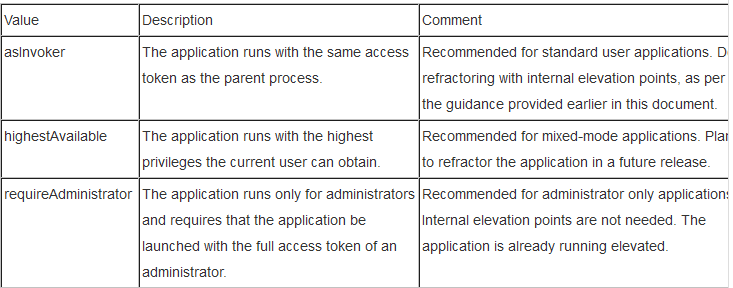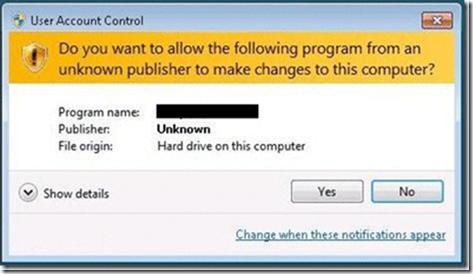一、通過配置文件實現以管理員身份運行程序
Vista 和 Windows 7 操作系統為了加強安全,增加了 UAC(用戶賬戶控制) 的機制,如果 UAC 被打開,用戶即使是以管理員權限登錄,其應用程序默認情況下也無法對系統目錄,系統注冊表等可能影響系統運行的設置進行寫操作。這個機制大大增強了系統的安全性,但對應用程序開發者來說,我們不能強迫用戶去關閉UAC,但有時我們開發的應用程序又需要以 Administrator 的方式運行,即 Win7 中 以 as administrator 方式運行,那麼我們怎麼來實現這樣的功能呢?
我們在 win7 下運行一些安裝程序時,會發現首先彈出一個對話框,讓用戶確認是否同意允許這個程序改變你的計算機配置,但我們編寫的應用程序默認是不會彈出這個提示的,也無法以管理員權限運行。本文介紹了 C# 程序如何設置來提示用戶以管理員權限運行。
首先在項目中增加一個 Application Manifest File

默認的配置如下:
<?xml version="1.0" encoding="utf-8"?>
<asmv1:assembly manifestVersion="1.0" xmlns="urn:schemas-microsoft-com:asm.v1"
xmlns:asmv1="urn:schemas-microsoft-com:asm.v1" xmlns:asmv2="urn:schemas-microsoft-com:asm.v2"
xmlns:xsi="http://www.w3.org/2001/XMLSchema-instance">
<assemblyIdentity version="1.0.0.0" name="MyApplication.app" />
<trustInfo xmlns="urn:schemas-microsoft-com:asm.v2">
<security>
<requestedPrivileges xmlns="urn:schemas-microsoft-com:asm.v3">
<!-- UAC Manifest Options
If you want to change the Windows User Account Control level replace the
requestedExecutionLevel node with one of the following.
<requestedExecutionLevel level="asInvoker" uiAccess="false" />
<requestedExecutionLevel level="requireAdministrator" uiAccess="false" />
<requestedExecutionLevel level="highestAvailable" uiAccess="false" />
If you want to utilize File and Registry Virtualization for backward
compatibility then delete the requestedExecutionLevel node.
-->
<requestedExecutionLevel level="asInvoker" uiAccess="false" />
</requestedPrivileges>
</security>
</trustInfo>
</asmv1:assembly>
URL:http://www.bianceng.cn/Programming/csharp/201410/45784.htm
我們可以看到這個配置中有一個 requestedExecutionLevel 項,這個項用於配置當前應用請求的執行權限級別。這個項有3個值可供選擇,如下表所示:

asInvoker : 如果選這個,應用程序就是以當前的權限運行。
highestAvailable: 這個是以當前用戶可以獲得的最高權限運行。
requireAdministrator: 這個是僅以系統管理員權限運行。
默認情況下是 asInvoker。
highestAvailable 和 requireAdministrator 這兩個選項都可以提示用戶獲取系統管理員權限。那麼這兩個選項的區別在哪裡呢?
他們的區別在於,如果我們不是以管理員帳號登錄,那麼如果應用程序設置為 requireAdministrator ,那麼應用程序就直接運行失敗,無法啟動。而如果設置為 highestAvailable,則應用程序可以運行成功,但是是以當前帳號的權限運行而不是系統管理員權限運行。如果我們希望程序在非管理員帳號登錄時也可以運行(這種情況下應該某些功能受限制) ,那麼建議采用 highestAvailable 來配置。
關於requestedExecutionLevel 設置的權威文檔請參考下面鏈接:
Create and Embed an Application Manifest (UAC)
下面是修改後的配置文件:
<?xml version="1.0" encoding="utf-8"?>
<asmv1:assembly manifestVersion="1.0" xmlns="urn:schemas-microsoft-com:asm.v1"
xmlns:asmv1="urn:schemas-microsoft-com:asm.v1" xmlns:asmv2="urn:schemas-microsoft-com:asm.v2"
xmlns:xsi="http://www.w3.org/2001/XMLSchema-instance">
<assemblyIdentity version="1.0.0.0" name="MyApplication.app" />
<trustInfo xmlns="urn:schemas-microsoft-com:asm.v2">
<security>
<requestedPrivileges xmlns="urn:schemas-microsoft-com:asm.v3">
<!-- UAC Manifest Options
If you want to change the Windows User Account Control level replace the
requestedExecutionLevel node with one of the following.
<requestedExecutionLevel level="asInvoker" uiAccess="false" />
<requestedExecutionLevel level="requireAdministrator" uiAccess="false" />
<requestedExecutionLevel level="highestAvailable" uiAccess="false" />
If you want to utilize File and Registry Virtualization for backward
compatibility then delete the requestedExecutionLevel node.
-->
<requestedExecutionLevel level="requireAdministrator" uiAccess="false" />
</requestedPrivileges>
</security>
</trustInfo>
</asmv1:assembly>
配置文件修改後,我們運行應用程序,就會首先彈出這樣一個提示框,點 Yes 後,程序才可以繼續運行,並且獲得系統管理員的權限。

下面再來看看程序如何知道當前運行在系統管理員權限還是非系統管理員權限:
public static bool IsAdministrator()
{
WindowsIdentity identity = WindowsIdentity.GetCurrent();
WindowsPrincipal principal = new WindowsPrincipal(identity);
return principal.IsInRole(WindowsBuiltInRole.Administrator);
}
這段代碼可以用於判斷當前程序是否運行在系統管理員權限下。如果配置為 asInvoker,在win7 下,這個函數會返回 false ,如果是 requireAdministrator 則返回 true。
二、通過編程以管理員身份運行程序
在讀寫注冊表“HKEY_LOCAL_MACHINE\SOFTWARE\”下的項時,明明注冊表中有,但程序OpenSubKey始終返回Null,考慮到可能是因為權限的原因,於是我以管理員身份運行了一次,結果測試成功!原來真的是權限的問題,於是就在程序裡面加入了默認以管理員身份運行的代碼。下面讓我們看看是怎麼實現的吧!
程序默認以管理員身份運行
static void Main(string[] Args)
{
/**
* 當前用戶是管理員的時候,直接啟動應用程序
* 如果不是管理員,則使用啟動對象啟動程序,以確保使用管理員身份運行
*/
//獲得當前登錄的Windows用戶標示
//URL:http://www.bianceng.cn/Programming/csharp/201410/45784.htm
System.Security.Principal.WindowsIdentity identity = System.Security.Principal.WindowsIdentity.GetCurrent();
//創建Windows用戶主題
Application.EnableVisualStyles();
System.Security.Principal.WindowsPrincipal principal = new System.Security.Principal.WindowsPrincipal(identity);
//判斷當前登錄用戶是否為管理員
if (principal.IsInRole(System.Security.Principal.WindowsBuiltInRole.Administrator))
{
//如果是管理員,則直接運行
Application.EnableVisualStyles();
Application.Run(new Form1());
}
else
{
//創建啟動對象
System.Diagnostics.ProcessStartInfo startInfo = new System.Diagnostics.ProcessStartInfo();
//設置運行文件
startInfo.FileName = System.Windows.Forms.Application.ExecutablePath;
//設置啟動參數
startInfo.Arguments = String.Join(" ", Args);
//設置啟動動作,確保以管理員身份運行
startInfo.Verb = "runas";
//如果不是管理員,則啟動UAC
System.Diagnostics.Process.Start(startInfo);
//退出
System.Windows.Forms.Application.Exit();
}
}
打開程序集裡的Program.cs文件,並將其中Main方法中的代碼替換為以上代碼即可實現程序默認以管理員身份運行。